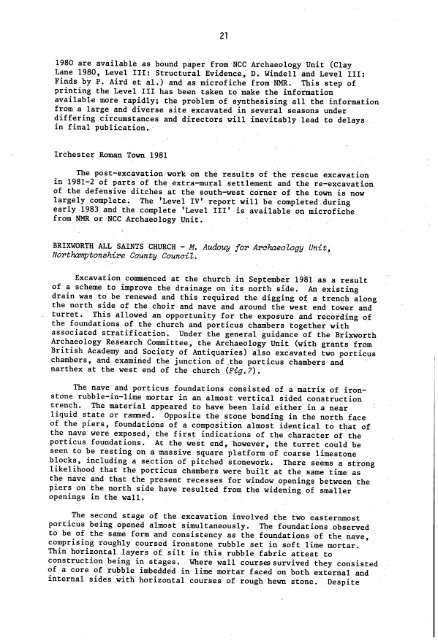CBA SMA\SMA 1983.PDF - Council for British Archaeology
CBA SMA\SMA 1983.PDF - Council for British Archaeology
CBA SMA\SMA 1983.PDF - Council for British Archaeology
You also want an ePaper? Increase the reach of your titles
YUMPU automatically turns print PDFs into web optimized ePapers that Google loves.
21<br />
1980 are available as bound paper from NCC <strong>Archaeology</strong> Unit (Clay<br />
Lane 1980, Level III: Structural Evidence, D. Windell and Level III:<br />
Finds by P. Aird et al.) and as microfiche from NMR. This step of<br />
printing the Level III has been taken to make the in<strong>for</strong>mation<br />
available more rapidly; the problem of synthesising all the in<strong>for</strong>mation<br />
from a large and diverse site excavated in several seasons under<br />
differing circumstances and directors will inevitably lead to delays<br />
in final publication.<br />
Irchester Roman Town 1981<br />
The post-excavation work on the results of the rescue excavation<br />
in 1981-2 of parts of the extra-mural settlement and the re-excavation<br />
of the defensive ditches at the south-west corner of the town is now<br />
largely complete. The 'Level IV' report will be completed during<br />
early 1983 and the complete 'Level III' is available on microfiche<br />
from NMR or NCC <strong>Archaeology</strong> Unit.<br />
BRIXWORTH ALL SAINTS CHURCH - M. Audouy <strong>for</strong> <strong>Archaeology</strong> Unit,<br />
Northamptonshire County <strong>Council</strong>.<br />
Excavation commenced at the church in September 1981 as a result<br />
of a scheme to improve the drainage on its north side. An existing<br />
drain was to be renewed and this required the digging of a trench along<br />
the north side of the choir and nave and around the west end tower and<br />
turret. This allowed an opportunity <strong>for</strong> the exposure and recording of<br />
the foundations of the church and porticus chambers together with<br />
associated stratification. Under the general guidance of the Brixworth<br />
<strong>Archaeology</strong> Research Committee, the <strong>Archaeology</strong> Unit (with grants from<br />
<strong>British</strong> Academy and Society of Antiquaries) also excavated two porticus<br />
chambers, and examined the junction of the porticus chambers and<br />
narthex at the west end of the church (Fig.?).<br />
The nave and porticus foundations consisted of a matrix of ironstone<br />
rubble-in-lime mortar in an almost vertical sided construction<br />
trench. The material appeared to have been laid either in a near<br />
liquid state or rammed. Opposite the stone bonding in the north face<br />
of the piers, foundations of a composition almost identical to that of<br />
the nave were exposed, the first indications of the character of the<br />
porticus foundations. At the west end, however, the turret could be<br />
seen to be resting on a massive square plat<strong>for</strong>m of coarse limestone<br />
blocks, including a section of pitched stonework. There seems a strong<br />
likelihood that the porticus chambers were built at the same time as<br />
the nave and that the present recesses <strong>for</strong> window openings between the<br />
piers on the north side have resulted from the widening of smaller<br />
openings in the wall.<br />
The second stage of the excavation involved the two easternmost<br />
porticus being opened almost simultaneously. The foundations observed<br />
to be of the same <strong>for</strong>m and consistency as the foundations of the nave,<br />
comprising roughly coursed ironstone rubble set in soft lime mortar.<br />
Thin horizontal layers of silt in this rubble fabric attest to<br />
construction being in stages. Where wall courses survived they consisted<br />
of a core of rubble imbedded in lime mortar faced on both external and<br />
internal sides with horizontal courses of rough hewn stone. Despite

















